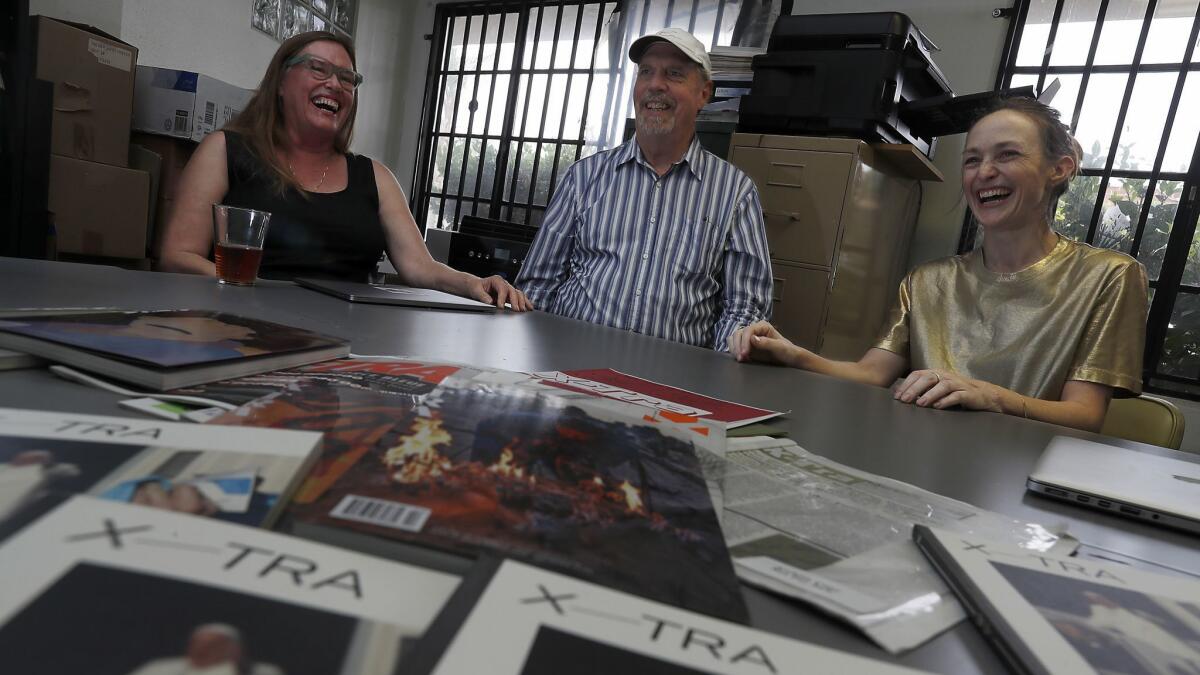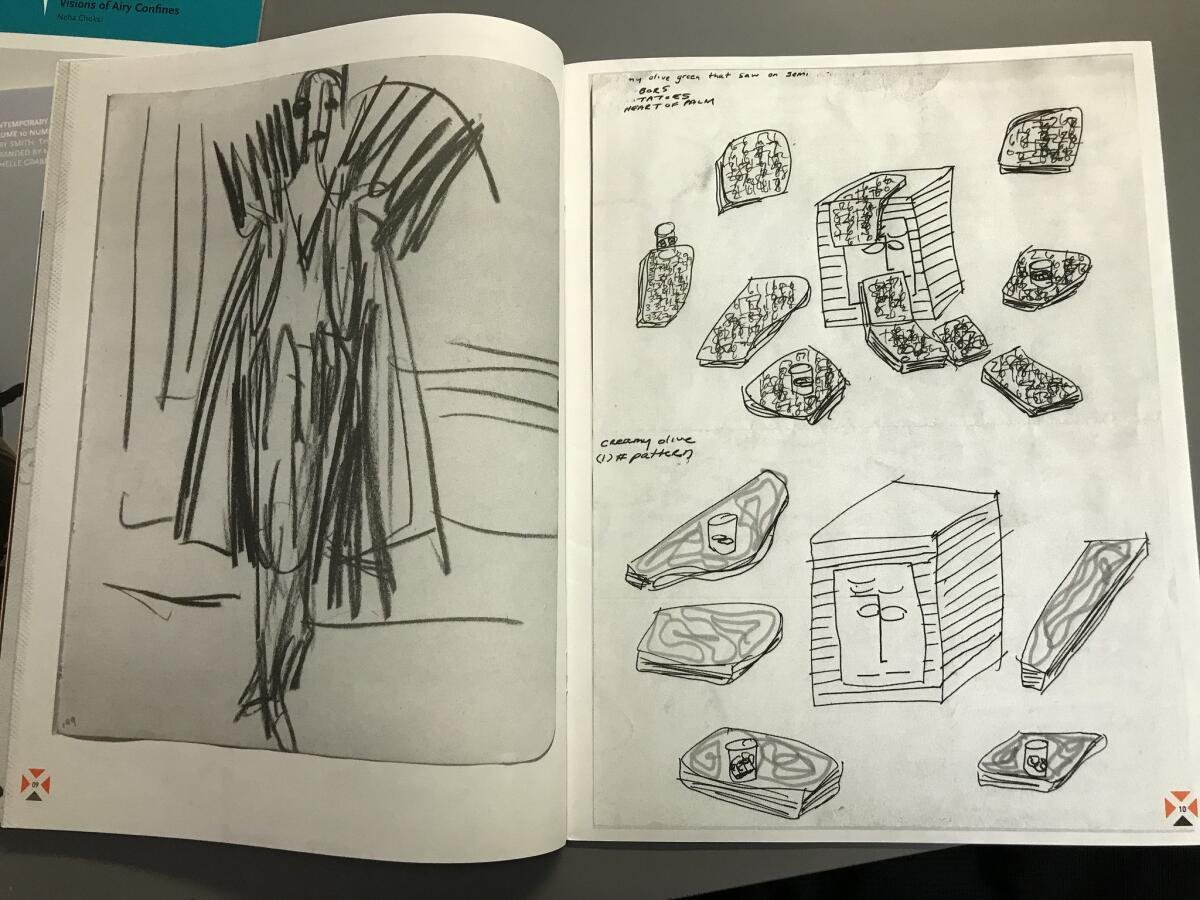It started as a one-shot publication — 20 years later X-TRA magazine is celebrating two decades of art

- Share via
In spring 1997, Los Angeles artists Ellen Birrell and Stephen Berens published the first issue of a newsprint art magazine they called X-TRA. The plan, says Berens, was to put out a single issue — “and we wouldn’t publish another one until we had money to publish another issue.”
That first issue contained a call-out stating something along the lines of, “We’ll do this again if you send us money,” recalls Birrell.
For the record:
3:15 p.m. Oct. 8, 2018An earlier version of this story misspelled the name of artist Dorit Cipys and identified artist Pope.L as “William,” a name he no longer uses. In addition, Shana Lutker now serves as executive director.
“All of a sudden, we had $300,” Berens says with a laugh. “So we had to do another.”
And another. X-TRA is still going strong — evolving into a quarterly now published in full color on glossy stock.
This year, X-TRA has been marking its 20th anniversary — a year after its actual anniversary. (More on that later.) The magazine is celebrating with a fresh design and a series of public events that draw from the publication’s own history. Among them: “Something About Feet,” a conversation between dancer Simone Forti and artist Dorit Cypis on Wednesday evening in downtown Los Angeles that will serve as a continuation of a dialogue the two artists have been having at events and in the pages of the magazine since 2004.
“It’s about looking back on the archives,” says Birrell. “We’ve referred back to X-TRA’s literary contributions and other things in the past.”
Over its two decades of existence, X-TRA has told the story of art from the point of view of artists: essays, criticism and art commissions featuring photography, drawings, video stills, cut-up texts and stirring fiction by the likes of nationally known artists such as Pope.L (which he read at an event staged by X-TRA at the Underground Museum in August).
“We don’t cover the entire waterfront — it’s never been up-to-date journalism,” says Birrell, seated amid boxes of issues in the magazine’s cluttered Glassell Park office. “It’s asking people, ‘What’s bugging you? What are you interested in?’”
Over time, those interests have included stories about how the marketplace has shaped art, the queer Chicano art scene and the work of artists who hail from L.A. and beyond: the nihilistic Raymond Pettibon, the multifarious Laura Owens, Frances Stark and her artfully placed words, and international stars such as Cindy Sherman — the latter of whom had her 2016 show at the Broad museum reviewed in X-TRA in a piece that opened with an anecdote about death by cosmetics.
A single issue — like the one that came out this past winter — can slingshot between a heady analysis of work by an artist who ran with European Situationists to a page filled with patterns that can be transformed into origami of an L.A. River carp (a project by artist Devon Tsuno).
Its artist-to-artist feel was what drew conceptual artist Shana Lutker to volunteer at the publication when she was in graduate school at UCLA in the early 2000s.
“I think I see an art magazine that is run by artists as a way for artists to communicate and share ideas,” she says. “You could feel it was this artist-driven project, and I just responded to that.”
Lutker now serves as the magazine’s executive director and helps organize much of its public programming.
“Though when I started, my job title was ‘Office,’” she says with a laugh. “For many years, I was ‘Office.’ One day someone pointed out that wasn’t right. That’s when I asked if I could be ‘managing editor.’” (She became executive director in 2014.)
“Office” has been one of the many quirks of X-TRA. There is also its slightly off anniversary year. The intent had been to celebrate with the launch of Volume 20 in the magazine’s 20th year, which would have been 2017 — but due to the idiosyncrasies of production (namely, the fact that the earliest issues didn’t always go out on schedule), most of the Volume 20 issues have landed in 2018. Close enough for a 20th anniversary.
“It’s very X-TRA,” says Lutker.
Quite appropriately, X-TRA was born not in a magazine office but in an art studio. It was the early ’90s, and Berens and Birrell were sharing a space in a warehouse in downtown Los Angeles that was regularly broken into by junkies who’d make off with their belongings.
“The art market sort of crashed,” says Berens. “Galleries started closing.”
The two began to organize exhibitions in whatever spaces they could lay their hands on: college art galleries, arts education spaces and a historic home-turned-cultural center in Orange County that was in the midst of a renovation project.
“In that downturn period, you could have stuff anywhere and people would show up,” says Berens.
The pair, both conceptual artists, did away with standard curatorial protocol, in which a theme would be devised and artists would be invited accordingly.
“Instead, we’d get the space and then we’d invite an artist that was prompted by that space,” says Birrell. “We’d talk about it and then they’d invite someone who was inspired by the space, so there was no central axis; it was lateral.”
Their first show was titled “First Show” and was held at the Guggenheim Gallery at Chapman University. Its name harked back to the first exhibition at the Museum of Contemporary Art Los Angeles in 1983, which was titled “The First Show: Painting and Sculpture From Eight Collections, 1940-80.”
“The introduction to our show was MOCA’s introduction, with everything that didn’t apply to us crossed out,” says Berens. “A lot got crossed out.”
Their curatorial collective was called Project X. And one of their modus operandi was to publish a slim catalog with each exhibition — often in newsprint — that contained not only information about the exhibition but also essays and other imagery that would be of interest on their own.
It was these catalogs that would evolve into X-TRA.

I view it to this day as this grand artists’ project. It was run by artists. It’s still run by artists.
— Jeff Beall, artist and publisher, X-TRA magazine
To their publication, Berens and Birrell applied the same rules they applied to their shows: There was no top editor to say yea or nay to articles. Instead, these were decided by an editorial board of artists and writers who invited fellow artists and writers to contribute; those figures invited others. (X-TRA still operates in this way.)
And while budgets were limited, experimentation was not. There was an issue that featured cutout paper dolls and another that was devoted entirely to drawing — as in: no text, only drawings.
“We invited designers, and they had total autonomy,” recalls Birrell. “So sometimes they weren’t very readable — like one which had blue pages that can’t be Xeroxed. Or we couldn’t get the rights to images, because we didn’t have any money, so we had artists draw things, like Manet’s ‘Olympia.’”
For their fifth issue, they featured a project by artist Brian Tucker that consisted of reproducing fliers created by a crank in New York who regularly attacked the hypocrisies of the art world. (Sample headline: “That Obnoxious Fraud: The Art Critic — How He Bamboozles You and How Brainless He Thinks You Are.”)
Over the years, X-TRA has drawn a rotating cast of artist volunteers who have contributed stories, edited work and helped get issues out to subscribers. Artist Jeff Beall has been one of the longest-running. Part of the magazine’s staff since 2001, he now serves as a publisher.
“When I first joined, I think the annual budget was like $12,000, and it was done sort of officially-unofficially on Stephen’s personal taxes,” he says with a laugh. “So the business model was: Make everything zero out so it doesn’t screw up Stephen’s taxes.”
In 2002, Beall helped establish a foundation to fund the publication — the Project X Foundation (of which Lutker serves as executive director). Since then, the magazine has gone from being a giveaway in galleries to a real-deal publication with subscribers and newsstand distribution. Over the years, they have been the recipient of numerous grants, including a prestigious Warhol Foundation grant in 2014.
At its 20-year (plus one) mark, X-TRA is looking both forward and back. Still dedicated to the print object, but now producing work that resides only online. But its ethos remains the same.
“I view it to this day as this grand artists’ project,” says Beall. “It was run by artists. It’s still run by artists.”
Along with other independent art publications in Los Angeles — Art Issues (now defunct), Artillery (which has been around for a dozen years), Contemporary Art Review Los Angeles (a recent addition) — X-TRA has helped expand the story of art.
“It’s important that there is a broad range of shows being reviewed and written about,” says Berens. “Want to go back and see what somebody thought of Manet? You could read Zola — not what we think about Manet now, but what it looked like at the time. If you looked at Los Angeles in that way, there’d be this narrow slice of what is going on. It was important to open that up.
“Fifty years from now, people can sort out what was happening. For me as an artist, that is such an important thing.”

‘X-TRA Forum No 3: Something About Feet’
A life conversation between Simone Forti & Dorit Cypis
When: 7:30 p.m. Oct. 10
Where: Navel, 1611 S. Hope St., downtown Los Angeles
Info: x-traonline.org
ALSO:
The conservator who is bringing lost stories of California’s pioneering female artists to light
Victor Hugo’s rarely seen art is as intimate and innovative as his famous books
Bulky, heavy, pricey - yet flourishing. Art catalogs keep print alive in the digital era
Sign up for our weekly Essential Arts & Culture newsletter »
carolina.miranda@latimes.com | Twitter: @cmonstah
More to Read
The biggest entertainment stories
Get our big stories about Hollywood, film, television, music, arts, culture and more right in your inbox as soon as they publish.
You may occasionally receive promotional content from the Los Angeles Times.











